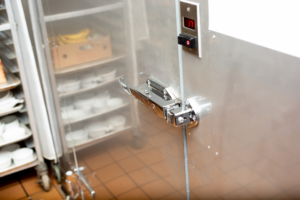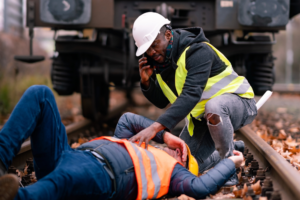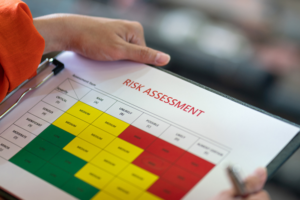Staying safe in refrigerated areas
A London branch of Pret a Manger has been fined £800,000 after a worker was stuck in a walk-in freezer for two and a half hours. The employee suffered suspected hypothermia after she was trapped in the -18°C freezer wearing just jeans and a t-shirt.
An investigation by Westminster City Council found that the company had not conducted a risk assessment for employees working in temperature-controlled environments. It had also failed to act on a number of similar incidents caused by defective freezer buttons and faulty door release mechanisms.
This story sends a shiver down the spine, but it could have been much worse. If you work with walk-in machinery, it’s vital to maintain it in good working order. Inspect equipment regularly and record the findings. If you find a fault, stop using the machinery until you can get it fixed.
If your employees are working in refrigerated areas, make sure you have conducted a full risk assessment beforehand. Take steps to limit the amount of time workers spend here, and provide gloves and jackets if necessary. If age or illness makes an employee more vulnerable to the cold, consider assigning them a different task. If you would like an expert review of your practices in refrigerated areas, get in touch.
Martyn’s Law – New responsibilities for hospitality
A change of government always means a change of legislative tack with many of the old regime’s bills never to see the light of day. Following last month’s King’s Speech, however, one thing we know for sure is that Labour will uphold plans to place greater responsibility on public venues to defend against terrorism.
During the speech, the government committed to enacting Martyn’s Law. Named after Martyn Hett, one of the victims of the Manchester Arena bombing in 2017, this legislation will put the onus on venues to reduce the likelihood and impact of terror attacks.
While the exact details of the law are still unknown, it seems that it will group premises into two tiers. Venues that hold more than 100 people will be expected to take basic precautions, while those that hold more than 800 will need to undertake more extensive actions. These may include providing counterterrorism training, conducting enhanced risk assessments and implementing a security plan. We will keep you updated as the bill passes through parliament.
Do you need a workwear policy?
You’ve probably noticed that workplace dress codes have become a lot more casual in recent years. This is a welcome change for many of us, but casual clothing can create unforeseen dangers. This was demonstrated in tragic fashion by a recent prosecution.
Last month, an industrial door manufacturer in Aberdeen was fined £165,000 after an employee was suffocated by a piece of machinery. One of the company’s mechanics was fatally strangled after his hoodie became tangled in the mechanism of the torsion spring he was servicing. Colleagues managed to cut him free, but he later died in hospital.
Although the company had repeatedly told employees not to wear loose clothing, it had failed to put in place a formal clothing policy. The investigation also found that no safe system of work was in place for dangerous tasks, and that the company had neglected to provide adequate training and supervision to ensure best practices were followed.
While this may seem like a freak accident, it should be a wakeup call for companies whose workers perform high risk activities. If your work involves heavy machinery or equipment with moving parts, it’s important to think carefully about what your employees are wearing. Include this in your risk assessment, noting the types of clothing that could create a particular danger.
If you identify multiple risks, the best option may be to introduce a workwear policy. If you have any questions about what to include in this, don’t hesitate to get in touch.
What can we learn from the latest HSE fatality statistics?
Following on from last November’s illness and injury statistics, the HSE has released its annual summary of work-related fatalities. While there are no big surprises in the data, there are a few key points that are worth mentioning.
There were 138 deaths in the 2023/24 period, an increase of two from the previous year. Slight fluctuations in these numbers are common, so this is not a statistically significant increase. Fatality numbers have remained broadly flat over the last ten years, with the exception of 2020 when deaths fell as a result of pandemic closures.
Another point of similarity is the danger profile of each industry. As usual, the majority of fatal injuries occurred in construction, agriculture, forestry and fishing and manufacturing. Of the 138 total fatalities, 90 occurred within these sectors. Construction saw the most total fatalities with 51, while agriculture, forestry and fishing had the highest fatality rate of 7.51 per 100,000.
Fatality demographics are also largely unchanged. Male workers continue to make up the vast majority of workplace deaths, suffering 95% of this year’s fatal accidents. Workers over 60 are also disproportionately vulnerable, accounting for a third of all deaths despite only making up 11% of the workforce.
While the three most common causes of death are still falls from height, being struck by a moving vehicle and being struck by a moving object, this year’s data show a significant increase in falls from height. This was the cause of 50 deaths, much higher than the five year average of 37. While the reasons for this are unclear, it should act as a warning for employers whose staff frequently perform tasks at height.
Whatever industry you work in, these statistics shouldn’t be cause for complacency. While fatalities have dropped massively over the last 50 years, they have remained flat for the last decade. This suggests that some fresh approaches might be needed to get things moving in the right direction.
At the H&S Dept, we believe that one workplace death is one too many. We make it our mission to ensure that you and your employees are doing everything necessary to reduce the risk of injury and death on the job. Whether it’s designing a risk assessment and implementing a safe system of work or providing refresher training courses for employees, we’re here to make sure safety standards never slip. Give us a call to find out the many ways in which we can help.
eLearning of the month: Risk assessments
A solid risk assessment is the cornerstone of workplace health and safety. You have a legal and moral responsibility to protect your employees from danger, and you can’t do this without first examining and recording these dangers.
A good risk assessment does more than identify surface-level risks. It goes deeper, rooting out hidden dangers and finding the employees who might be especially vulnerable. Getting this right takes practice, but it can make a huge difference to overall safety.
When a business employs five people or more (including the employer), it is required by law to have an H&S competent person. Many choose to outsource this role to an independent expert like us. This is a great way to ensure that nothing is missed, but this approach can be complemented with in-house training, and our eLearning courses are a fast and cost-effective way to do this.
We offer accredited online courses in every possible aspect of health and safety, including risk assessments. Our specially designed risk assessment module will teach you everything you need to create and implement a highly effective risk assessment. eLearning courses can be completed in as little as 30 minutes, making them a great way to upskill your staff without disrupting the daily workflow. Give us a call or click here to find out more.






